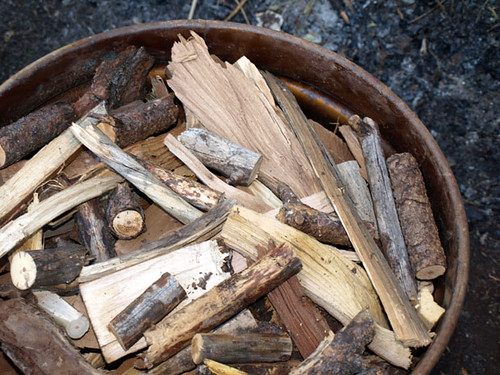 Saturday last I drove into town to try to procure two 30 gallon metal barrels for my biochar retort kiln project. I had in mind a two-barrel system similar to this one only larger, with a 30-gallon drum nestled inside a 55-gallon one. Though he was initially reluctant, I closed the deal on 2 of the barrels, and brought them home.
Saturday last I drove into town to try to procure two 30 gallon metal barrels for my biochar retort kiln project. I had in mind a two-barrel system similar to this one only larger, with a 30-gallon drum nestled inside a 55-gallon one. Though he was initially reluctant, I closed the deal on 2 of the barrels, and brought them home.
A call to the El Dorado County burn hotline and it was on – a permissive burn day! Using an inappropriate tool – in this case a now useless wood chisel, I cut twenty or so one-and-a-half inch flaps in the bottom of the outer barrel, and then cut the top from same (pictured to the right). I then cut slits in the metal every six inches or so, in order to make it easier to cap the outer barrel. I also cut a hole in the top of the lid for a chimney/afterburner, and attached an easily-removed five foot long piece of stove pipe.
Construction complete, I set about filling the smaller barrel with biochar stock, consisting mostly of seasoned madrone and pine branches, and chips and flakes left from this year’s wood splitting – the hydraulic splitter tends to generate a fair number of these flakes, especially when splitting crooked-grained wood like madrone.
I put the large outer barrel on top of the small, full barrel, then inverted the whole business. I filled the space between the inner and outer barrels with twigs and various broken branches and wood from some old palettes, then built fire on top of the 30-gallon barrel. Once the whole business seemed to be burning, I put the cap on the outer barrel and attached the chimney, then monitored and coaxed the fire by way of the air holes at the bottom. Here’s where the flaws in my design were revealed.
put the large outer barrel on top of the small, full barrel, then inverted the whole business. I filled the space between the inner and outer barrels with twigs and various broken branches and wood from some old palettes, then built fire on top of the 30-gallon barrel. Once the whole business seemed to be burning, I put the cap on the outer barrel and attached the chimney, then monitored and coaxed the fire by way of the air holes at the bottom. Here’s where the flaws in my design were revealed.
As it turns out, I don’t think that the 30/50 dual-barrel design is going to work. There just isn’t enough room between the inner and outer barrels for fuel sufficient to keep a hot fire going. Drag. The best-laid schemes o’ mice an’ men gang aft agley.
I took the lid off of the outer barrel, dumped the whole business out, and then recollected all of the charcoal stock in the smaller barrel, then lit that. Once the fire was hot and self-sustaining, I put the outer barrel back on, flipped the whole thing back over again, and tried to once again create a fire in the space between the inner and outer barrels. No luck.
Finally, I decided that it would be best to remove the inner barrel entirely, and so I dumped all of the wood into the larger barrel, made sure it was burning hot, and capped it. By adjusting the air intake vents (by blocking them with dirt), and fussing with the bunghole – stop snickering – I was able to get a really hot fire going. I added another barrel to the top as an afterburner (as in this stacked two-barrel example), and lo and behold bore witness to the vaunted wood gas effect. Bright, intense, clean and hot blue flames shot out of the barrel and lit up the afterburner, accompanied by jet engine sounds. Good times.
After a while, I removed the afterburner, blocked all of the air intakes, capped the hole in the top of the outer barrel and covered the top with dirt to create tight seal and prevent oxygen from entering the system. In a short while all smoking ceased. My hope is that when I get home this evening and open the barrel up, I’ll be greeted with some quantity of glorious biochar, rather than a big pile of ash. I’ll let you know.


Pingback: Adventures in Biochar – Part II | food|forest|garden
Pingback: Biochar Compost FTW | food|forest|garden